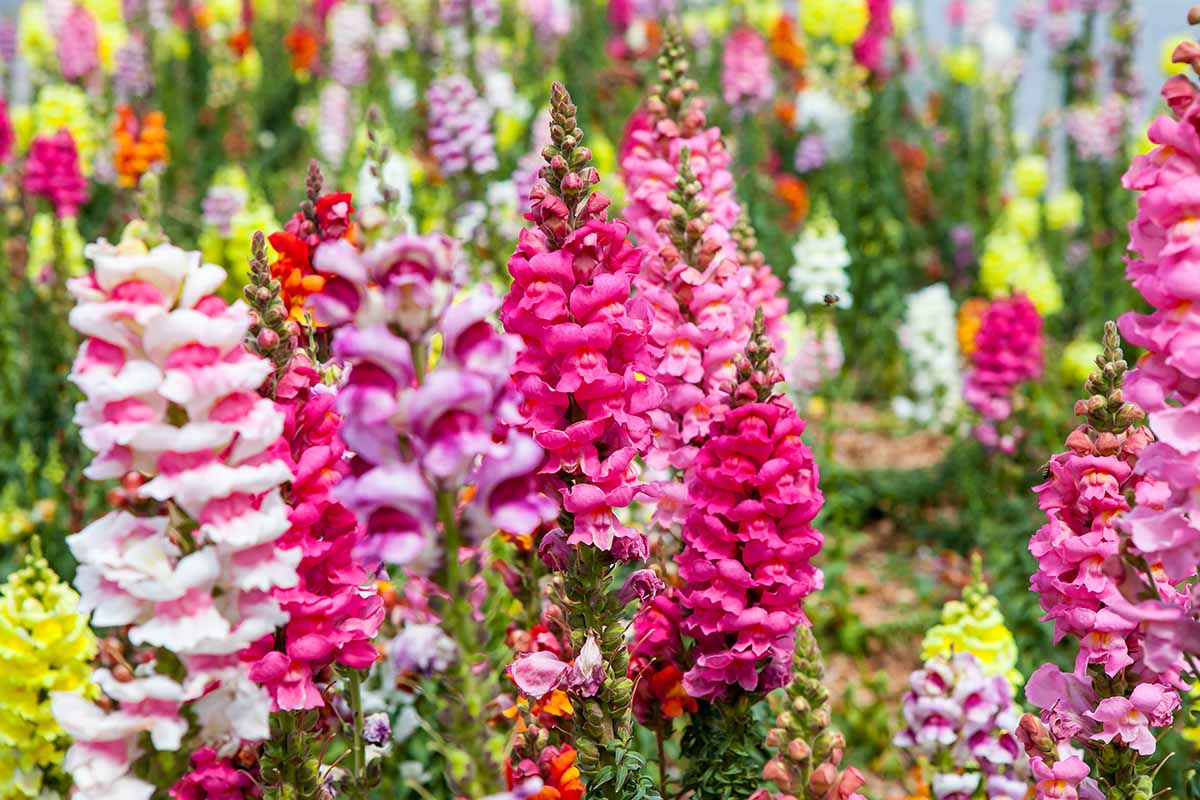Everything You Need to Know About Snap Dragon
Snap dragons, scientifically known as Antirrhinum, have long been celebrated for their enchanting beauty. These unique and whimsical flowers are characterized by their distinct snap-like shape, which allows them to open and close with a gentle squeeze. This captivating feature has given rise to their common name, “Snapdragon.”
They make a stunning addition to gardens, floral arrangements, and even as potted plants, adding a touch of elegance and charm wherever they are found.
Snapdragon plants are renowned for their versatility and adaptability. They come in various sizes, from compact dwarf varieties to taller, majestic spikes. These plants are well-suited to both garden beds and containers, making them a favorite among gardeners of all levels of expertise.
Snapdragons are not only visually appealing but also have a delightful fragrance, adding another layer of sensory enjoyment to any garden or floral display. They are known to attract pollinators, such as bees and butterflies, enhancing the ecological balance of their surroundings.
Botanical Background
Taxonomy and Scientific Classification
Snapdragons belong to the genus Antirrhinum and are part of the family Plantaginaceae. The scientific classification of Snapdragons is as follows:
- Kingdom: Plantae
- Phylum: Angiosperms
- Class: Eudicots
- Order: Lamiales
- Family: Plantaginaceae
- Genus: Antirrhinum
Native Regions and Habitats
Snapdragons have a diverse natural range, with species found in regions spanning from North America to Europe and North Africa. These plants can thrive in a variety of habitats, from open meadows and rocky slopes to dry, arid landscapes. They have adapted to different climates and altitudes, making them a resilient and hardy choice for gardeners worldwide.
Read Also: Ways to Make Money from Paint Recycling
Snapdragons have a rich botanical history, and their legacy continues to bloom in gardens, parks, and floral arrangements. In the following sections of this article, we will explore various aspects of Snapdragons, from their cultivation and care to the symbolic meanings they carry in different cultures. Whether you are a gardening enthusiast or someone looking to brighten your space with these charming blooms, there’s much to discover about the captivating world of Snapdragons.
Varieties of Snap Dragons
Snapdragons (Antirrhinum) come in a wide array of varieties, each offering its unique charm and characteristics. In this section, we will explore the common Snapdragon species and some popular cultivars and hybrids that are cherished by gardeners and flower enthusiasts around the world.
Snapdragons belong to the genus Antirrhinum, and several species are commonly cultivated. Here are a few noteworthy ones:
- Antirrhinum majus: This is the most common species, known for its tall spikes of colorful flowers and distinctive snap-like shape.
- Antirrhinum hispanicum: This species features delicate, smaller flowers in shades of lavender and pink. It’s often used as an ornamental plant in gardens.
- Antirrhinum multiflorum: As the name suggests, this species produces multiple flowers on each stem, creating a profusion of color.
Popular Cultivars and Hybrids
Gardeners and horticulturists have developed numerous cultivars and hybrids of Snapdragons, each with its unique characteristics and features. Some of the most popular ones include:
- Rocket Series: Known for their tall and robust spikes of vibrant, densely-packed flowers, the Rocket Series Snapdragons are a favorite for their striking visual impact.
- Sonnet Series: This series is cherished for its compact size and a wide range of colors, making it suitable for both garden beds and containers.
- Madame Butterfly Series: The double-petaled flowers of this series resemble butterflies in flight, adding an extra layer of elegance and charm to the garden.
- Candy Tops Series: Candy Tops Snapdragons are prized for their fragrance and are often used in cut flower arrangements, infusing any space with their sweet scent.
Growth and Cultivation of Snapdragons
Snapdragons are relatively easy to grow, and they thrive in a variety of conditions. In this section, we’ll explore the soil and sunlight requirements for Snapdragons, as well as the methods for planting and propagation.
Soil Requirements
- Well-Drained Soil: Snapdragons prefer well-drained soil to prevent waterlogging, which can lead to root rot. Amending heavy soils with organic matter can improve drainage.
- pH Level: Aim for slightly acidic to neutral soil with a pH range of 6.0 to 7.0. Soil testing and adjustment may be necessary to achieve the ideal pH.
Sunlight Requirements
- Full Sun to Partial Shade: Snapdragons thrive in full sun but can also tolerate partial shade. However, they may have fewer flowers in shadier conditions.
Planting and Propagation Method
Snapdragons can be propagated and planted as follows:
- Seeds: Snapdragons are commonly grown from seeds. Sow the seeds in early spring or late summer for fall blooms. Make sure to keep the soil consistently moist until the seedlings are established.
- Transplants: Many gardeners prefer starting with transplants purchased from nurseries or garden centers. Transplants can be planted in the garden after the last frost date in the spring.
- Deadheading: To encourage continuous flowering, regularly deadhead (remove spent blooms) Snapdragons. This not only keeps the plant looking tidy but also prompts it to produce more flowers.
- Division: Perennial Snapdragons can be divided every few years to rejuvenate the plant and promote better growth.
Care and Maintenance of Snapdragons
Snapdragons are relatively low-maintenance plants, but they do require proper care and attention to thrive and produce their enchanting blooms. In this section, we’ll explore essential aspects of caring for Snapdragons, including watering and fertilization.
Watering and Irrigation
Regular Watering:
- Consistent Moisture: Snapdragons prefer consistently moist soil. Water your plants when the top inch of the soil feels dry to the touch. Avoid overwatering, which can lead to root rot.
- Morning Watering: Water in the morning to allow the foliage to dry before evening, reducing the risk of fungal diseases. Avoid wetting the leaves, as this can encourage issues like rust.
Irrigation:
- Drip or Soaker Hose: Drip irrigation or a soaker hose is an efficient way to water Snapdragons. It delivers water directly to the root zone, minimizing water wastage.
- Mulch: Applying a layer of mulch around your Snapdragons helps retain soil moisture and regulates temperature. This is particularly beneficial during hot, dry periods.
- Container Snapdragons: If you’re growing Snapdragons in containers, ensure that the pots have proper drainage. Be vigilant about watering, as containers tend to dry out more quickly than garden beds.
Fertilization
Snapdragons benefit from appropriate fertilization to support healthy growth and prolific flowering:
- Balanced Fertilizer: Use a balanced, all-purpose fertilizer with an N-P-K (nitrogen-phosphorus-potassium) ratio of 10-10-10 or similar. Apply the fertilizer in early spring when new growth begins.
- Frequency: Fertilize your Snapdragons every 4 to 6 weeks during the growing season. Avoid excessive feeding, as this can lead to excessive foliage growth at the expense of flowers.
- Container Snapdragons: If you’re growing Snapdragons in containers, they may require more frequent fertilization. Container plants deplete nutrients faster due to limited soil volume.
- Avoid High Nitrogen: Be cautious with high-nitrogen fertilizers, as they can promote lush foliage growth at the expense of flower production. Look for a balanced fertilizer or one with a slightly higher phosphorus (P) content to encourage flowering.
- Organic Options: If you prefer organic gardening, consider using organic fertilizers such as compost or well-rotted manure. These provide slow-release nutrients and improve soil quality.
It’s essential to monitor the health and appearance of your Snapdragons. If the plants exhibit signs of nutrient deficiencies, such as yellowing leaves or stunted growth, adjust your fertilization routine as needed.
Snapdragons are versatile and adaptable, making them an excellent choice for gardeners of all levels of expertise. With the right care and attention to their soil and sunlight requirements, Snapdragons can brighten your garden or floral arrangements with their unique, colorful, and captivating blooms.
Whether you choose common species or popular cultivars, the Snapdragons will surely add a touch of enchantment to your outdoor spaces.
Read Also: A Comprehensive Guide to Owner Finance Homes




